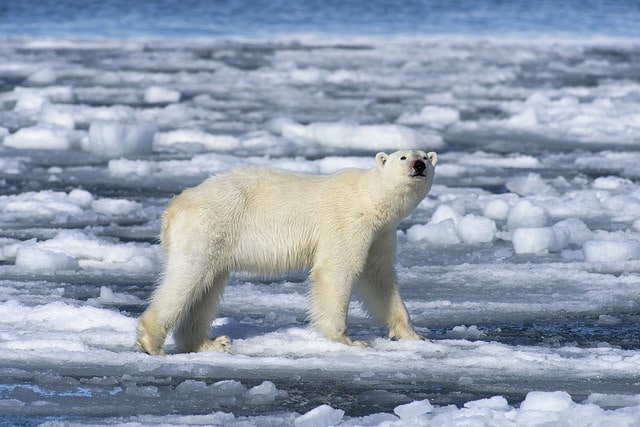Welcome to Svalbard: The Arctic’s Wildlife Capital
Picture yourself bundled up, standing on the deck of a small ship, scanning the icy horizon for a glimpse of a polar bear. Svalbard, a Norwegian archipelago just 1,050 km from the North Pole, offers one of the world’s best chances to see these majestic creatures in their natural habitat. With its dramatic fjords, towering glaciers, and vibrant wildlife, a Svalbard polar bear tour is a bucket-list adventure that blends thrill, beauty, and respect for nature. This guide dives into what you can expect, from wildlife encounters to practical tips, ensuring you’re ready for an unforgettable journey.
Why Choose a Svalbard Polar Bear Tour?
The Allure of Polar Bears
Polar bears, the Arctic’s iconic apex predators, draw adventurers to Svalbard’s icy shores. With an estimated 3,000 bears in the region—outnumbering the human population of 2,552—the archipelago is a prime spot for sightings. Their elusive nature and raw power make every encounter a heart-pounding moment, whether they’re hunting seals or wandering snow-covered cliffs.
Svalbard’s Unique Environment
Svalbard’s landscape is a surreal mix of jagged mountains, ice-filled fjords, and vast sea ice, creating a stunning backdrop for wildlife tours. The midnight sun bathes the region in 24-hour daylight from April to August, offering endless opportunities to explore. This rugged, untouched wilderness feels like a step into another world, perfect for nature lovers and photographers.
Responsible Wildlife Tourism
Svalbard’s tours prioritize ethical wildlife viewing, adhering to strict Association of Arctic Expedition Cruise Operators (AECO) guidelines. Operators ensure minimal disturbance to polar bears, maintaining safe distances (300–500 meters depending on the season). Choosing a responsible tour supports conservation efforts while offering a guilt-free adventure.
What to Expect on Your Tour
Types of Tours Available
Svalbard offers a range of polar bear tours, from multi-day expedition cruises to shorter snowmobile safaris. Most tours depart from Longyearbyen, the world’s northernmost town, and focus on northern and eastern Spitsbergen, where bears roam the sea ice. Small ships, like the 12-guest R/V Kinfish, provide intimate experiences, while larger vessels offer more amenities.
Daily Itinerary and Activities
Your tour will blend wildlife spotting with exploration of Svalbard’s landscapes. Expect daily Zodiac boat excursions to navigate fjords and ice floes, guided hikes on tundra, and onboard lectures from naturalists. Kayaking and photography sessions are often optional, letting you tailor your adventure to your interests.
Zodiac Excursions
Zodiac boats, small inflatable vessels, are the backbone of polar bear tours, allowing close access to ice edges where bears hunt. Guides navigate carefully, ensuring safe distances while maximizing sighting opportunities. You’ll feel the thrill of gliding through icy waters, eyes peeled for a bear’s white silhouette.
Guided Hikes and Landings
Onshore landings let you explore Svalbard’s tundra, where you might spot reindeer or Arctic foxes alongside polar bears. Armed guides ensure safety, as bears can appear anywhere. These hikes offer a chance to stretch your legs and soak in the Arctic’s raw beauty.
Onboard Experience
Life aboard a Svalbard cruise is cozy yet adventurous. Ships like the Greg Mortimer or National Geographic Endurance offer comfortable cabins, hearty meals, and expert-led talks on polar ecology. Expect buffet breakfasts, three-course dinners, and plenty of deck time to scan for wildlife.
Wildlife Beyond Polar Bears
While polar bears steal the show, Svalbard teems with other wildlife. Walruses bask on beaches, humpback whales breach in fjords, and Arctic terns soar overhead. The towering cliffs of Alkefjellet host thousands of Brünnich’s guillemots, creating a cacophony of life against the ice.
The Reality of Polar Bear Sightings
Polar bears are wild and unpredictable, so sightings aren’t guaranteed. Tours maximize chances by targeting pack ice and hunting grounds, but patience is key. Some cruises report a 95% success rate, while others note only 5% of day trips spot bears, making longer tours (7–14 days) your best bet.
Best Time to See Polar Bears in Svalbard
Seasonal Considerations
Summer (June–September) is prime time for polar bear tours, as melting ice allows ships to navigate fjords and reach bear habitats. July offers the best odds, with bears concentrating on remaining ice to hunt seals. Winter tours, like snowmobile safaris in February, are riskier but offer a snowy, polar night experience.
Weather and Conditions
Summer temperatures range from 3–7°C (37–44°F), with 24-hour daylight enhancing visibility. Expect chilly winds, fog, and occasional rain, but the midnight sun creates a magical glow. Winter tours face -20°C (-4°F) and polar night, requiring extra preparation for darkness and cold.
Ice and Wildlife Patterns
In early summer, sea ice clings to northern Svalbard, drawing polar bears to hunt seals. By late August, ice retreats 50 miles north, making sightings harder. Tours adjust routes based on ice conditions, often heading to Spitsbergen’s north or east for optimal bear encounters.
Planning Your Svalbard Polar Bear Tour
Choosing the Right Tour Operator
Selecting a reputable operator is crucial for safety and sustainability. Companies like Aurora Expeditions, Quark Expeditions, and Secret Atlas prioritize eco-friendly practices and small groups. Look for AECO certification, expert guides, and ships designed for polar navigation, like the X-Bow® Greg Mortimer.
Tour Length and Cost
Tours range from 7–24 days, with prices starting at $3,000 for shorter trips and reaching $17,200 for premium 12-day voyages. Costs typically include meals, excursions, and transfers from Longyearbyen. Budget extra for flights to Oslo and Longyearbyen, starting at $500 round-trip from Europe.
What to Pack
Packing smart ensures comfort in Svalbard’s harsh climate. Layering is key, as temperatures fluctuate. Bring a camera with a telephoto lens, as bears are often spotted from a distance, and your phone camera won’t cut it.
Essential Packing List
- Base Layer: Thermal underwear (wool or synthetic)
- Mid-Layer: Fleece or insulated jacket
- Outer Layer: Waterproof, windproof parka and pants
- Accessories: Wool beanie, scarf, sunglasses, insulated gloves
- Footwear: Warm socks, rubber-soled boots (operators often provide Wellington boots)
- Gear: Binoculars, telephoto camera, portable charger
Safety and Regulations
Polar bears are dangerous predators, and safety is paramount. Never venture outside Longyearbyen without a guide, as bears can roam near settlements. AECO guidelines mandate 300–500-meter distances from bears, and guides carry firearms for emergencies. Always follow their instructions to protect yourself and the bears.
A Personal Story: My Svalbard Dream
I’ve yet to set foot in Svalbard, but I imagine standing on a Zodiac, heart racing as a polar bear lumbers across an ice floe, its black eyes scanning the horizon. My friend, a wildlife photographer, returned from a 10-day cruise with tales of a mother bear teaching her cubs to swim, a moment that left her teary-eyed. She described the silence of the Arctic, broken only by the crackle of ice, and the thrill of spotting a bear after hours of patient waiting. Her stories fuel my longing to join a tour, camera in hand, ready to capture the Arctic’s raw magic.
Comparing Svalbard to Other Polar Bear Destinations
Svalbard vs. Churchill, Canada
Churchill, Manitoba, known as the “Polar Bear Capital,” offers land-based tours with near-guaranteed sightings in October–November. Svalbard’s ship-based tours, however, provide a broader Arctic experience, with fjords, glaciers, and diverse wildlife. Churchill is more accessible from North America, while Svalbard suits European travelers.
Svalbard vs. Greenland
Greenland’s northeast coast, like Scoresbysund, hosts polar bears but is less accessible than Svalbard. Svalbard’s infrastructure, with regular flights to Longyearbyen, makes it easier to plan. Greenland offers similar landscapes but fewer dedicated bear tours, making Svalbard the better choice for bear-focused trips.
Comparison Table
| Destination | Best Time | Tour Type | Accessibility | Cost Range | Wildlife Diversity |
|---|---|---|---|---|---|
| Svalbard | June–September | Ship-based | Easy (flights to Longyearbyen) | $3,000–$17,200 | Polar bears, walruses, whales, reindeer |
| Churchill | October–November | Land-based | Moderate (flights via Winnipeg) | $4,000–$10,000 | Polar bears, foxes, belugas |
| Greenland | July–August | Ship-based | Challenging (remote access) | $5,000–$15,000 | Polar bears, seals, whales |
Pros and Cons of a Svalbard Polar Bear Tour
Pros
- High chance of polar bear sightings (up to 95% on longer cruises)
- Stunning Arctic scenery with fjords, glaciers, and midnight sun
- Diverse wildlife, including walruses, whales, and seabirds
- Expert guides enrich the experience with ecological insights
- Small-group tours ensure intimate, eco-friendly adventures
Cons
- No guaranteed polar bear sightings, especially on short trips
- High costs for cruises and flights
- Harsh weather requires physical preparedness
- Limited travel season (summer for best conditions)
- Remote location demands flexible travel plans
Best Tools and Resources for Your Tour
Booking Platforms
- Polar Cruises: Compare itineraries and prices across operators. Polar Cruises
- Adventure Life: Tailored Arctic trips with expert support. Adventure Life
- TourRadar: Find deals and reviews for Svalbard tours. TourRadar
Gear Suppliers
- REI: High-quality Arctic clothing and gear. REI
- Patagonia: Sustainable outerwear for extreme conditions. Patagonia
- B&H Photo: Telephoto lenses for wildlife photography. B&H Photo
Conservation Resources
- Polar Bears International: Learn about bear conservation and citizen science. Polar Bears International
- Norwegian Polar Institute: Research on Svalbard’s ecosystems. Norwegian Polar Institute
Weather Apps
- Windy: Real-time Arctic weather updates. Windy
- AccuWeather: Reliable forecasts for Longyearbyen. AccuWeather
People Also Ask (PAA)
What is the best time to see polar bears in Svalbard?
The best time is June to September, with July offering peak conditions due to melting ice and bear activity on pack ice. Longer tours (10–14 days) increase sighting chances.
Are polar bear sightings guaranteed on Svalbard tours?
No, sightings aren’t guaranteed, as polar bears are wild and elusive. Longer cruises (7–14 days) report up to 95% success rates, while day trips have a 5% chance.
Is it safe to see polar bears in Svalbard?
Yes, with experienced guides and AECO regulations, tours are safe. Guides carry firearms, and ships maintain 300–500-meter distances from bears to protect both visitors and wildlife.
How much does a Svalbard polar bear tour cost?
Costs range from $3,000 for a 7-day cruise to $17,200 for a 12-day premium tour. Flights to Longyearbyen add $500–$1,000. Prices vary by operator and season.
FAQ Section
How do I prepare for a Svalbard polar bear tour?
Research operators, pack layered clothing, and bring a telephoto camera. Book with AECO-certified companies for safety and sustainability. Stay flexible, as weather can change itineraries.
What wildlife can I see besides polar bears?
Expect walruses, humpback whales, Arctic foxes, reindeer, and seabirds like Brünnich’s guillemots. Svalbard’s fjords and cliffs teem with life, especially in summer.
Can I see polar bears on a day trip in Svalbard?
Day trips have a low (5%) chance of sightings, as bears are farther north. Multi-day cruises to Spitsbergen’s ice edge offer better odds.
What should I pack for a Svalbard tour?
Pack thermal base layers, fleece mid-layers, waterproof outerwear, warm accessories, and a telephoto camera. Operators provide boots for landings. Check with your tour for specifics.
How does climate change affect Svalbard’s polar bears?
Warming melts sea ice, reducing hunting grounds and forcing bears to travel farther or scavenge on land. Tours support conservation efforts to protect their habitat.
Tips for an Unforgettable Svalbard Experience
- Book Early: Popular tours, especially small-group cruises, fill up fast. Reserve 6–12 months in advance.
- Stay Flexible: Weather and ice conditions can alter itineraries, so embrace the adventure.
- Learn Before You Go: Read about polar bears on Polar Bears International to deepen your appreciation.
- Support Conservation: Choose operators contributing to projects like the Norwegian Polar Institute’s marine mammal research.
- Capture the Moment: Practice with your camera’s zoom lens to nail those distant bear shots.
Conclusion: Your Arctic Adventure Awaits
A Svalbard polar bear tour is more than a wildlife trip—it’s a journey into Earth’s wildest frontier. From the thrill of spotting a polar bear on the ice to the awe of sailing past glaciers under the midnight sun, every moment feels surreal. With careful planning, the right gear, and a responsible operator, you’ll create memories that last a lifetime. Ready to embark? Start with Quark Expeditions or Secret Atlas to find your perfect tour. Pack your sense of wonder and get ready for the Arctic’s magic.






